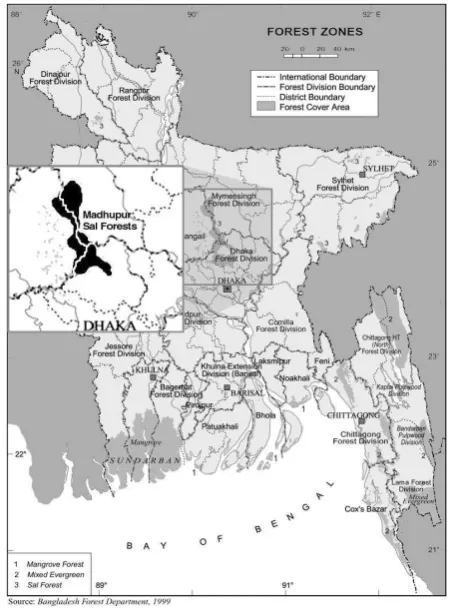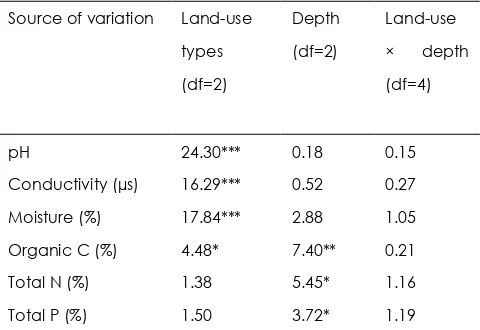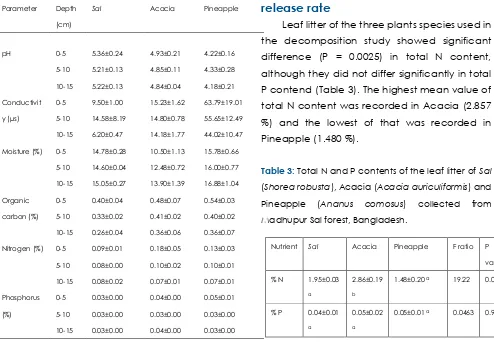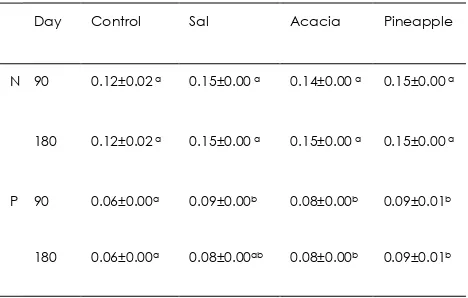EFFECTS OF LAND-USE CHANGE ON THE PROPERTIES OF TOP SOIL OF
DECIDUOUS SAL FOREST IN BANGLADESH
M. A. Kashem1, A. Ahmed1, S. Hoque2 and M. Z. Hossain1*
1Department of Botany, University of Dhaka, Dhaka-1000, Bangladesh
2Department of soil, Water and Environment, University of Dhaka, Dhaka 1000, Bangladesh
ABSTRACT
This study examined the effects of land use change on the physico-chemical properties of top soil in the deciduous Sal forest of Bangladesh. Relatively less disturbed Sal (Shorea robusta Roxb. Ex
Gaertn.) forest stands and the nearby stands those were converted into Acacia (Acacia
auriculiformis Benth.) plantation and pineapple (Ananus comosus (L.) Merr.) cultivation were selected to examine the effects of land use change on soil properties. For each land use type, soil samples were collected from 4 locations, 50m distant from each other, as replicates. Soil samples were collected at 0-5, 5-10, and 10-15 cm depths. Soil moisture content, conductivity, pH organic C, total N and total P were determined as soil properties. Leaf litter of Sal, Acacia and pineapple was incubation for 90 and 180 days in independent identical soil in order to examine the effects of plant species through leaf litter on the soil chemical nutrient (N and P) status. Data showed that soil moisture content, conductivity and pH were significantly affected by land use but not by depth. However, soil organic C was affected by both land-use type (P< 0.02) and soil depth (P< 0.003), although no significant interactions appeared between these two factors. Soil total N and P did not differ between land use types but by depth and, N and P contents decreased with the increase of depth. Rates of nutrients (N and P) released from Sal, Acacia and pineapple did not differ significantly among them during incubation. Results of the present study reveal that properties of the top soil of the Madhupur Sal forest are different in their responses to the varying land uses. The
findings of this study are thus relevant for the sustainable management of the deciduous Sal forest
ecosystems.
KEYWORDS: Deciduous forests, land use change, nutrient release, topsoil
*Corresponding author: (Email: [email protected])
1. INTRODUCTION
Forest disturbances and land conversions are regarded as one of the major drivers of soil degradation [1]. Changes in land use are likely to affect soil properties through distribution and supply of soil nutrients [2]. Study on the effect of land use change on the
top soil is more relevant as it plays greater role in plants’ growth and development by
providing nutrients [3]. Moreover,
understanding the properties of top soil is important as the depth of top soil has proved a significant parameter in determining soil quality and land productivity [4, 5, 6].
The Sal forests dominated by Sal (Shorea robusta Roxb. Ex Gaertn.) in the central plains and north-western regions of Bangladesh are
deciduous forests. The Sal forests of
Bangladesh are severely impacted by many forms of human induced activities including deforestation, litter collection, plantation and cultivation with introduced plant species [7]. Understanding the physical and chemical properties of forest soil is important because of their influence on productivity and nutrient cycling of the ecosystem [8]. Moreover, adequate knowledge about the effects of landuse changes on soil properties is
necessary before taking program like
plantation or cultivation of crop in the Sal
forests. However, there is limited knowledge on the effects of land-use changes on the properties of soil of Sal forest in Bangladesh. The main objective of this study was to assess
and compare the changes in the
physico-chemical properties of soils and nutrient release rates of litter and explore the relationships among soil properties of the different land use types.
2. MATERIALS AND METHODS
2.1 Site description
The Sal forest in the Madhupur tract, also known as Madhupur Garh, is situated in the district of Tangail (Figure 1). The forest is moist
deciduous in nature and located from 24.300 to
24.500 N and 900 to 90.100 E. The annual rainfall
of the area is ca. 1800 mm, 90% of which occurs
in the period of May through October [9]. The average temperature of the area ranges from 30.3 to 20.9ºC across the year [10]. Three
different land-use types namely natural Sal
forest, Acacia plantation and Pineapple cultivation were selected for the collection of soil samples.
Figure 1: Map of the study area (black shaded) of the Madhupur Sal forest in Bangladesh.
2.2 Collection and analysis of soil
samples
Soil samples were collected from the sites under the three kinds of land use types. For each land-use type, four locations, 50 m distant from each other, were selected to collect soil at 0-5, 5-10 and 10-15cm. Thus, a total of 36 soil samples, each 12 from the three land-use types were selected.
Soil pH and electrical conductivity were determined in suspension with distilled water with the ratios 2:1 and 5:1 (v: w), respectively. Soil moisture content was measured by weight loss after drying 10 g fresh soil at 80°C for 24h. Soil total N was determined by following the Kjeldahl method [11]. Soil P
content was extracted with HNO3 and HClO4
and determined by color development using a spectrophotometer at 440 nm [12]. Soil
Mym T
organic carbon was determined by Walkley and Black method [11].
2.3 Litter chemistry, decomposition and
nutrient release rate
Three plant species Sal (Shorea robusta),
Acacia (Acacia auriculiformis) and
Pineappple (Ananus comosus) grown in the
forests were selected to collect leaf litter for the analysis of leaf N and P, decomposition rate and N and P release rate from leaf litter after incubation. Fresh leaves were collected from the field and then brought to the
laboratory and then dried at 600C for 24 hours.
Soil used for incubation of the litter was
collected from the Botanical garden,
Department of Botany, University of Dhaka. Soil used in the decomposition study was characterized for chemical properties (pH 7.0, electric conductivity 53.7 µs, moisture content 20.35%, total N 0.117% and total P (0.062%). Part of the dried leaves of all species was cut into 2 cm × 2 cm long in size to make the leaves of similar size before incubation. Then 1 g leaf litter of each of litter species was mixed with 450g soil already taken into the pot. The leaves were mixed well with soil using forceps.
Pots were then covered by sterilized
polythene bag to avoid contamination. Triplicate replications were used for each treatments including control (soil without litter). Autoclaved water was added in such a way that all pot received similar moisture content throughout the period of the experiment. The pots were kept for incubation
at room temperature. Samples were
collected destructively after 90 days and 180 days for the analysis of rates of mass loss and release of N and P into soil. On day after completion of 90 days and 180 days, the un-decomposed leaf litter was collected from
the pot and rinsed thoroughly with distilled water to remove soil. Litter was then
oven-dried for 24 h at 600C. The mass
remaining was then calculated for study of decomposition rate at 90 and 180 days.
3. RESULTS
3.1 Soil physico-chemical properties
Two-way ANOVA statistics on the effects on landuse type, depth and their interaction on the soil physico-chemical properties are shown in Table 1. Data showed that although soil moisture content, conductivity and pH were significantly affected only by landuse type, soil organic C content was affected by both landuse type (P< 0.02) and soil depth (P< 0.003), nevertheless no significant interactions appeared. Soil total N and total P was affected by depth but not by land-use.
Table 1: Overall Two-way ANOVA statistics (F-
ratios) of the effects of land-use type, depth and
their interaction on the properties of top soil in the
Madhupur Sal forest area, Bangladesh.
Source of variation Land-use
types the physico-chemical properties of soil measured at
Sal forest, Acacia plantation and Pineapple cultivation in the Madhupur Sal forest, Bangladesh
Parameter Depth
5-10 14.58±8.19 14.80±0.78 55.65±12.49
10-15 6.20±0.47 14.18±1.77 44.02±10.47
Moisture (%) 0-5 14.78±0.28 10.50±1.13 15.78±0.66
5-10 14.60±0.04 12.48±0.72 16.00±0.77
10-15 15.05±0.27 13.90±1.39 16.88±1.04
Organic Pineapple cultivation and the highest was found in the Sal forest sites. Highest conductivity value (63.79 µs) was reported in Pineapple cultivation while the lowest of that was recorded in Sal forest. The Pineapple cultivation also showed the highest moisture content (16.88%) compared to that in the Acacia plantation and Sal forest sites. Significantly higher value of soil organic C in the Pineapple cultivation (0.540%) was recorded at 0-5 cm depth and that was lowest in the Sal forest (0.255%) at 10-15 cm depth. Soil total N and P did not show any significant difference among
land-use types they showed significant
difference among the different depth. Soil total N and P gradually decreased from upper layer (0-5 cm) to the lower (10-15 cm) layer.
3.2 Litter decomposition and nutrient
release rate
Leaf litter of the three plants species used in the decomposition study showed significant difference (P = 0.0025) in total N content, although they did not differ significantly in total P contend (Table 3). The highest mean value of total N content was recorded in Acacia (2.857 %) and the lowest of that was recorded in Pineapple (1.480 %).
Table 3: Total N and P contents of the leaf litter of Sal
(Shorea robusta), Acacia (Acacia auriculiformis) and Pineapple (Ananus comosus) collected from
4. DISCUSSION AND CONCLUSION
Soil moisture, conductivity and pH are found to respond differently to various human induced managements following conversion from natural deciduous forests. Changes in physical properties due to landuse change have been reported by substantial number of studies. Significant difference in soil pH among various landuses has been reported by other studies[13,14].
Table 4: Two-way ANOVA statistics of the effects of litter species, incubation time and their interactions on the mass remaining (g) and soil total N (%) and
P (%) contents of leaf litter of Sal, Acacia and Pineapple.
The lowest mean pH value in the Pineapple cultivation might be associated with
high organic C as found in the present study. Organic C i.e. high organic matter might have been responsible for acidic condition through generation of humic acid in these sites compared to the other land-use types [13]. Although the three landuse types differed significantly among them the overall soil pH was slightly acidic among the land-use types. This forest was previously reported to exhibit low pH value [15,16]. Significant difference in the soil moisture content found in the present study might be related to the identity of the dominant tree species in the land types. The lowest soil moisture content found in Acacia plantation might be due to the reason that this fast growing legume species might require more moisture for maintaining its fast growth
compared to other species. Further, it is also likely that high moisture content in the Pineapple cultivation might be associated with watering by the farmers during the cultivation season of this crop.
Like many other studies[13,17,18], this study also reported that soil organic C significantly differed among the landuses. Cultivation of Pineapple and plantation of fast growing Acacia might be related with the higher production of organic matter in these
two land use types than that found in the Sal
forest which is a mature and stable forest ecosystem. Soil organic C content declined with the increase of soil depth across landuse
types. This could be due to higher during incubation. Different letters indicate
significance of difference.
Mass remaining gradually decreased from the starting time (initial) to 180 days
most easily and hardly, respectively,
Parameter Litter Day Litter*Day
Mass remaining 55.30*** 465.18*** 14.94***
Total N 3.80* 0.11 0.16
Total P 13.58*** 0.26 0.31
Incubation time (day)
Sal Acacia Pineapple
Initial 1.00±0.00 a 1.00±0.00 a 1.00±0.00 a
90 0.63±0.04a 0.69±0.01a 0.33±0.02 b
decomposable litter used in the present study. On day 90, Pineapple leaf litter showed the lowest mass remaining i.e. highest mass loss rate and the highest soil N and P release rates while Acacia leaf litter showed the lowest mass loss rate and the lowest N and P release rates (Table 5 and 6) indicating that mass loss rate and litter quality are positively correlated. Other studies also reported similar results.
High-quality litter (N-rich) enhances
decomposition rate at an early stage [20,21,22] because such litter provides readily
available C for microbes; nutrients released from soil consequently promote microbial
growth and activity. Nitrogen content of plant
tissues is important in controlling the rate of
decomposition according to some
studies[23,24]. However, on day 180, mass remaining did not correlate with the N and P release rates indicating that other factors phenolic compounds in the leaf litter tissues and microbial community composition might be related with the litter decomposition rate
180 0.06±0.00a 0.08±0.00ab 0.08±0.00b 0.09±0.01b
The result that the three land-use types in Madhupir Sal forest did not differ in soil N and
P content may be due to the reason that in spite of the difference in litter N content decomposition of the leaf litter is not determined by the leaf N content in the long run in the Sal forest. Land use change was
also reported not to affect significantly soil
total N and total P[24].The reason for low
responses of the soil chemical properties including total N and P to different management activities has been ascribed to the nature of the parent material of the soil. Andosols have been reported to show slow response to the different management activities [26]. Soils with rich in pumice and allophanic are more resistant to degradation
due different management systems[27]. The
soils of the Madhupur Sal forest have been identified as Red-Brown Terrace soils and as Orthi-Ferric Acrisols by the FAO-UNESCO system[28]. Acidic nature of these soils might be related with the less availability of the N and P. However, higher content of soil total N and P in the uppermost (0-5 cm) soil layer might be due to the highest accumulation of litter in the upper layer. Overall, result of the management of the forests ecosystems through conversion into other landuse/cover.
Acknowledgements:
The authors arethankful to the Centre for Advanced Studies
and Research in Biological Sciences,
Department of Botany, University of Dhaka for help in collecting samples from the field.
References
[1] P.A. Matson, K.A. Lohse, S.J. Hall, The globalization of nitrogen deposition: consequences for
terrestrial ecosystems. Ambio. 31 (2002)113-119 [2] D. Murty, M.U.F. Kirschbaum, R.E. Mcmurtrie, H.
Mcgilvray, Does conversion of forest to
agricultural land change soil carbon and nitrogen? A review of the literature, Global
Change Biology 8 (2002) 105-123
[3] X.M. Fang, F.S. Chen, S.Z. Wan, Q.P. Yang, J.M.
Shi, Top soil and deep soil organic carbon concentration and stability vary with aggregate
size and vegetation type in subtropical China.
PLOS ONE 10(9): (2015)
e0139380.doi:10.1371/journal.pone.0139380. [4] N. Brunel, F. Meza, R. Ros, F. Santibáñez, Effects of
topsoil loss on wheat productivity in dryland zones
of Chile. J. Soil Sci. Plant Nutr. 11(2011) 129-137 [5] R.J. Harper, M. Tibbett, The hidden organic
carbon in deep mineral soils. Plant Soil 368 (2013) 641–648
[6] C. Rumpel, L. Koegel-Knabner, Deep soil organic matter-a key but poorly understood component
of terrestrial C cycle. Plant Soil 338 (2011) 143–158
[7] K.B.S. Rasheed, Participatory forestry as a strategy
for reforestation in Bangladesh. Geo Journal 37 (1995) 39-44
[8] S.G. Baer, J.M. Blair, S. Collins., A.K. Knapp, Soil
resources regulate productivity and diversity in newly established tallgrass prairie. Ecology 84
(2003) 724-735
[9] E.B. Manalo, Agro-climatic survey of Bangladesh.
BRRI/IRRI. Los Banos, Leguna, Philippines (1976)
[10] C.Q. Ghani, A. Alim, P.R. Stevens, Rehabilitation
and land use planning of Sal forests, parts I, II, and III. FAO/UNDP Project 85/085, Assistance to the
forestry sector, Phase II, Dhaka, FAO (1990)
[11] C.A. Black, Methods of soil and plant analysis. Part I and II. American Society of Agronomy
(1965)
[12] M.L. Jackson. Soil Chemical Analysis.
Prentice-Hall. NJ (1958)
[13] V. Agoumé, A.P. Birang, Impact of Land-use
Systems on some Physical and Chemical Soil Properties of an Oxisol in the Humid Forest Zone of Southern Cameroon. TROPICULTURA 27 (2009)
15-20
[14] S.Y. Korkanc, N. Ozyuvaci, A. Hizal, Impacts of
land use conversion on soil properties and soil erodibility. Journal of Environmental Biology 29
(2008) 363-370
[15] M.Z. Hossain, A. Okubo, S. Sugiyama, Effects of
grassland species on decomposition of litter and soil microbial communities. Ecol Res. 25 (2010)
Land use effects on the composition of organic matter in particle-size separates of soil: I Lignin
and carbohydrate signature. Eur. J. Soil Sci. 45(1994) 449-458
[19] T. Chibsa, T.A. Asefa, Assessment of Soil Organic Matter under Four Land Use Systems in the Major
Soils of Bale Highlands, South East Ethiopiab. Factors Affecting Soil Organic Matter
Distribution. World Applied Sciences Journal 6 (2009) 1506-1512
in a semi-arid grassland. Appl. Soil Ecol.23 (2003) 13–23
[21] T. Teklay, A. Nordgren, G. Nyberg, A. Malmer, Carbon mineralization of leaves from four Ethiopian agroforestry species under laboratory and field conditions. Appl. Soil. Ecol. 35 (2007) 193–202
[22] M.Z. Hossain, S. Sugiyama, Effects of chemical composition on the rate and temporal pattern of decomposition in grassland species leaf litter. Grassland Science 54 (2008) 40–44
[23] W.P.K. Findlay, Studies in the physiology of wood destroying Fungi. The effect of nitrogen
content upon the rate of decay of timber. Annals of Botany 48, (1934) 109-117
[24] H.S. Miller, F.B. Smith, P.E. Brown, The rate of decomposition of various plant materials in soils. J. American Soc. Agr. 28 (1936) 914-923
[25] V. Geissen, R. Sánchez-Hernández, C. Kampichler, R. Ramos-Reyes, A.
Sepulveda-Lozada, S. Ochoa-Goana, B.H.J. de Jong, E. Huerta-Lwanga, S. Hernández-Daumas, Effects of land-use change on some properties of tropical soils —An example from Southeast Mexico. Geoderma 151 (2009) 87–97
[26] D. Aran, M. Gury, E. Jeanroy, Organometallic
complexes in an Andosol: a comparative study with a Cambisol and Podzol. Geoderma 99 (2001) 65–79
[27] W.E. Cotching, R.F. Allbrook, H.S. Gibbs, Influence of maize cropping on the soil
structure of two soils in the Waikato district, New Zealand. New Zealand J.Agr. Res.
22 (1979) 431-438
[28] K.R. Islam, R.R. Weil, Land use effects on soil
quality in a tropical forest ecosystem of Bangladesh. Agriculture, Ecosystems and




